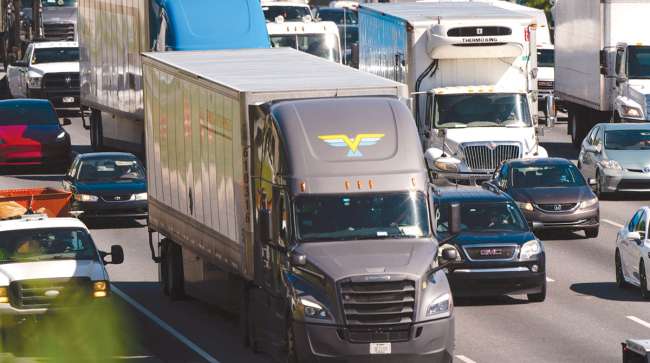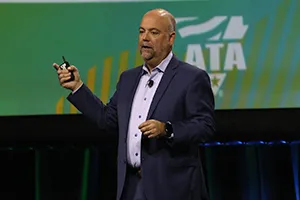Senior Reporter
Economy Still Shows Signs of Slow, Steady Growth

[Stay on top of transportation news: Get TTNews in your inbox.]
Even with a stronger-than-expected 2.9% fourth quarter increase in gross domestic product, two of the nation’s most prominent freight transportation economists say the threat of a recession will persist this year.
Bob Costello, American Trucking Associations’ chief economist, and Rajeev Dhawan, director of the Economic Forecasting Center at Georgia State University, said, however, that the economy continues to perform at a strong level.
“It’s a unique time right now for the macroeconomy,” Costello told Transport Topics in the publication’s Newsmakers interview. “I still think that the most likely path for the economy is a recession, a mild recession in the first half of the year and what’s called a so-called soft landing is not out of the question. I don’t think that’s the most likely path. I think we could have a mild recession, but it should be rather short and rather shallow for the overall economy.”

ATA Chief Economist Bob Costello (John Sommers II for Transport Topics)
Costello said that if there is a recession, he forecasts the economy to contract by 1% to 1.5% in the first or second quarter, then recover and show full-year growth of 0.5% GDP.
He added that one of the factors keeping the economy stronger than some experts had expected is that the job market remains strong — the 3.5% unemployment rate is the lowest since 1969.
Dhawan said economy still is strong but beginning to show signs of gradual slowing as consumers begin to pull back on spending.

Dhawan
“The economy is doing better than I expected at this time. The stock market is having a bit of a rally this year and the last part of 2022, but durable goods spending, big ticket items, cars, washing machines, appliances, things like that, are down,” Dhawan told TT. “With the higher interest rates, they have fallen a bit in the last month, but they are still more than twice what they were a year ago, and that’s hurting the housing market.”
But the housing industry is beginning to show signs of life after enduring a rough second half of 2022, according to residential real estate brokerage company Redfin Corp. in its latest housing report Jan. 25.
“The housing market has begun to recover after hitting a low point in the second week of November. We’re not out of the woods yet, but home buyers are coming off the sidelines: The number of Redfin customers requesting first tours has improved 17 percentage points from the November trough, and the number of people contacting Redfin agents to start the home buying process has improved 13 points,” the report said. “Compared with a year ago, home tours and requests for service are down 23% and 27% respectively, but that’s an improvement from the November trough, when both were down 40%.”

Host Seth Clevenger speaks with Torc Robotics CEO Peter Vaughan Schmidt about the realities of autonomous truck technology and how they fit into the freight transportation industry. Hear the program above and at RoadSigns.TTNews.com.
Second of a three-part series on autonomous vehicles. Hear Part I here. Part III coming Feb. 2.
Housing and real estate are critical sectors for the trucking industry, because many materials for home builders and home furnishings are transported by trucks.
To back up Costello’s and Dhawan’s assesments on the state of the economy, the National Retail Federation in its final report on 2022’s holiday sales, said consumers increased year-over-year spending by 5.3% to $936.3 billion, which fell slightly short of the organization’s forecast of growth between 6% and 8%.
However, full-year retail sales grew by 7% over 2021’s mark to $4.9 trillion, meeting NRF’s forecast of between 6% and 8% growth for the year.
“The last two years of retail sales have been unprecedented, and no one ever thought it was sustainable,” NRF President and CEO Matthew Shay said. “Nonetheless, we closed out 2022 with impressive annual retail sales and a respectable holiday season despite historic levels of inflation and interest rate hikes to cool the economy.”

Full-year retail sales grew by 7% over 2021’s mark to $4.9 trillion, according to the National Retail Federation. (Patrick T. Falloon/Bloomberg News)
Costello said the trucking industry continues to see growth, and he pointed to the December’s ruck tonnage index, which showed a 3.8% year-over-year increase and a 0.3% month-to-month rise.
Costello told TT that while those numbers are solid, the industry likely will see a slowdown in freight because the economy is regaining a more traditional position — spending on goods and services is coming back into balance. During the height of the pandemic, he said, consumers were spending on items such as furniture, televisions and computers, and staying off airplanes and out of hotels. But that’s changing, and there could be repercussions for trucking in 2023.
“I think that we’re going to have a mild recession early next year,” @ATAEconBob Costello said. By @ConnorInTheNews #ATAmce22 https://t.co/JiGHisqSOP — Transport Topics (@TransportTopics) October 25, 2022
“The freight market is worse than the macroeconomy.” Costello noted. “If you’ve been on a plane recently, they’re packed. People are going back to sporting events, they’re going back to the movies. People are not spending as much on goods as they were. Freight decelerated in the fourth quarter, and there was no traditional peak season.”
Want more news? Listen to today's daily briefing below or go here for more info:




